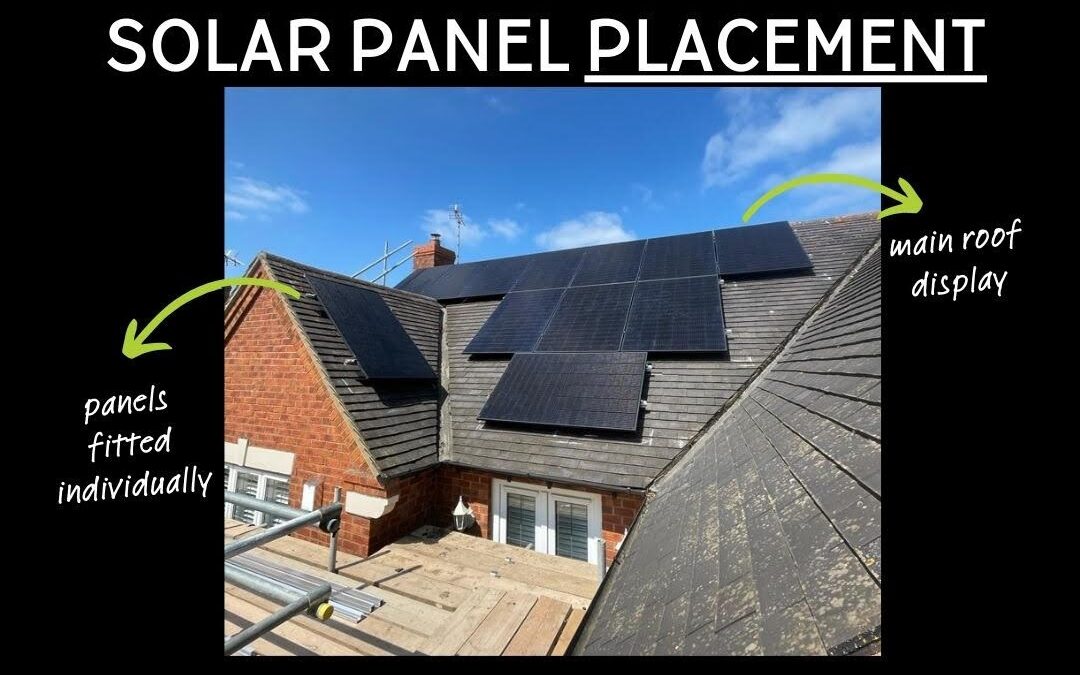Solar panels are a great way to generate clean and renewable energy for your home or business. But how do you choose the best placement for your solar panels to get the most out of them? In this blog post, I will explain some of the factors that affect the performance of solar panels and how to optimize their orientation and angle in the UK.
Why does solar panel placement matter?
The placement of your solar panels matters because it determines how much sunlight they can capture and convert into electricity. The more sunlight your panels receive, the more power they produce and the more money you save on your energy bills.
The amount of sunlight that reaches your solar panels depends on several factors, such as:
- The direction they face
- The angle they are tilted at
- The location and climate of your area
- The time of the year and day
- The presence of any shading or obstructions
By choosing the best placement for your solar panels, you can maximize their exposure to the sun and increase their efficiency and output.
Which direction should solar panels face?
The direction that your solar panels face is also known as their azimuth angle. This is the angle between the north direction and the direction that your panels point to. For example, if your panels face directly south, their azimuth angle is 0 degrees. If they face east, their azimuth angle is 90 degrees.
The best direction for solar panels depends on which hemisphere you live in. In the northern hemisphere, solar panels should face south for best performance. In the southern hemisphere, they should face north. This is because the sun is always in the southern half of the sky in the northern hemisphere, and vice versa in the southern hemisphere.
Facing your panels south or north ensures that they receive direct sunlight for most of the day as the sun moves across the sky. However, this is not always possible due to the shape or orientation of your roof or other limitations. In that case, you can also consider east or west-facing panels, which can still produce a good amount of energy, especially in the morning or evening hours.
However, you should avoid north-facing panels in the northern hemisphere and south-facing panels in the southern hemisphere, as they receive very little direct sunlight throughout the year.
Which angle should solar panels be tilted at?
The angle that your solar panels are tilted at is also known as their elevation angle. This is the angle between the horizontal plane and the plane of your panels. For example, if your panels are flat on the ground, their elevation angle is 0 degrees. If they are vertical on a wall, their elevation angle is 90 degrees.
The best angle for solar panels depends on your latitude and the season. Latitude is the distance from the equator measured in degrees. For example, London has a latitude of 51 degrees north, while Sydney has a latitude of 34 degrees south.
The optimal elevation angle for solar panels is equal to your latitude during winter solstice, when the sun is at its lowest point in the sky. This ensures that your panels receive maximum sunlight during the shortest days of the year.
However, this angle may not be ideal for other seasons, when the sun is higher in the sky. Therefore, some experts recommend adjusting your elevation angle according to this formula:
Elevation angle = Latitude – 15 degrees in summer Elevation angle = Latitude + 15 degrees in winter Elevation angle = Latitude in spring and autumn
This way, you can optimize your solar panel output throughout the year by following the sun’s position.
However, this may not be feasible or practical for some installations, especially if your panels are fixed on your roof. In that case, you can use an average elevation angle that works well for most seasons. A good rule of thumb is to use an elevation angle equal to your latitude minus 10 degrees.
For example, if you live in London (latitude 51 degrees north), you can use an elevation angle of 41 degrees for your solar panels.
How to find out your optimal solar panel placement?
If you want to find out the best placement for your solar panels based on your location and roof characteristics, you can use online tools such as solar panel calculator UK or solar maps. These tools can help you estimate how much energy your solar panels can produce depending on their direction and angle.
You can also consult with professional solar installers who can assess your site and design a customized solar system that suits your needs and preferences.
Conclusion
Solar panel placement is an important factor that affects the performance and output of your solar PV system. By choosing the optimal direction and angle for your solar panels, you can maximize their exposure to sunlight and generate more clean and renewable energy for your home or business.
I hope this blog post has helped you understand some of the basics of solar panel placement and how to choose the best option for your situation. If you have any questions or comments, feel free to leave them below. I would love to hear from you!
Are you ready to invest in Solar Panels and convert to clean, renewable energy?
If you are a UK homeowner and interested in learning more about how much money you could save with a Solar PV System, contact our expert solar energy team today. We specialise in Solar Panel Installations Essex, but we also do installations across the south-east of the UK. By filling out our contact form, our team will provide you with a free no-obligation quote to install a bespoke solar PV system, catered to your personal energy needs. Call us on 01268 928 690 or click the ‘Enquire Now’ button below to claim your free no-obligation quote and solar PV system design.
Frequently Asked Questions about Solar Panels
The short answer is yes. Solar panels can cut 70% off your energy bills, and that proportion is growing as gas bills rise. No wonder installations have risen by 45% in the last three years, and shot up by 80% in the last year alone. But solar panels are an investment.
1-2 bedroom property, 6 solar panels generating about 1,600 kWh a year.
3 bedroom property, 10 solar panels generating about 2,650 kWh a year.
4-5 bedroom property, 14 solar panels generating about 3,700 kWh a year.
The answer depends on how much you pay for the solar panels, how much your electricity would otherwise cost, how much green energy the panels make from the sunshine you get, and whether you have a battery installed or not. The average payback period for solar PV is coming down and can be about 10 to 20 years depending on your system.
The industry standard for most solar panels’ lifespans is 25 to 30 years. Most reputable manufacturers offer production warranties for 25 years or more. The average break even point for solar panel energy savings occurs six to 10 years after installation.
Whilst there is no hard and fast rule as to how much value solar panels can add to the overall value of your property, suggestions range from 4% to 14% on average and they are certainly unlikely to detract from the value of your home, even if they aren’t the most attractive feature visually.
Latest Solar Panel Posts
- Why Leisure Centres Should Invest in Solar Panels
 In recent years, the concept of sustainability has become increasingly vital in various industries, including leisure centres. As the global focus shifts towards environmental conservation and renewable energy sources, leisure centres are recognizing the importance of investing in sustainable practices to reduce their operating costs and their carbon footprint. One such sustainable solution gaining traction… Read more: Why Leisure Centres Should Invest in Solar Panels
In recent years, the concept of sustainability has become increasingly vital in various industries, including leisure centres. As the global focus shifts towards environmental conservation and renewable energy sources, leisure centres are recognizing the importance of investing in sustainable practices to reduce their operating costs and their carbon footprint. One such sustainable solution gaining traction… Read more: Why Leisure Centres Should Invest in Solar Panels - Solar Panels and EPC Ratings
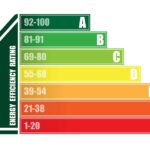 Solar panels have become increasingly popular as a sustainable energy solution, offering numerous benefits for both residential and commercial properties. In parallel, Energy Performance Certificate (EPC) ratings serve as indicators of a building’s energy efficiency. Understanding how solar panels can impact EPC ratings is crucial for maximizing energy savings and environmental benefits. This blog post… Read more: Solar Panels and EPC Ratings
Solar panels have become increasingly popular as a sustainable energy solution, offering numerous benefits for both residential and commercial properties. In parallel, Energy Performance Certificate (EPC) ratings serve as indicators of a building’s energy efficiency. Understanding how solar panels can impact EPC ratings is crucial for maximizing energy savings and environmental benefits. This blog post… Read more: Solar Panels and EPC Ratings - SunSynk Batteries: Innovative Energy Storage
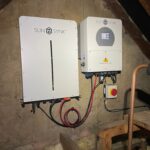 SunSynk Batteries have emerged as a leading solution in the realm of energy storage, offering a range of innovative features and benefits that cater to various applications. With a focus on sustainability and cutting-edge technology, SunSynk Batteries have captured the attention of residential, commercial, and industrial consumers alike. This blog post delves into the intricate… Read more: SunSynk Batteries: Innovative Energy Storage
SunSynk Batteries have emerged as a leading solution in the realm of energy storage, offering a range of innovative features and benefits that cater to various applications. With a focus on sustainability and cutting-edge technology, SunSynk Batteries have captured the attention of residential, commercial, and industrial consumers alike. This blog post delves into the intricate… Read more: SunSynk Batteries: Innovative Energy Storage - Solar Industry Update: Battery Installations in Lofts
 The British Standards Institute (BSI) has recently released new recommendations regarding home battery installations, including those in loft spaces. One common inquiry we receive from our customers following the publication of the Publicly Available Specification (PAS) is whether a solar battery can be installed in a loft. The answer is a resounding yes, with some… Read more: Solar Industry Update: Battery Installations in Lofts
The British Standards Institute (BSI) has recently released new recommendations regarding home battery installations, including those in loft spaces. One common inquiry we receive from our customers following the publication of the Publicly Available Specification (PAS) is whether a solar battery can be installed in a loft. The answer is a resounding yes, with some… Read more: Solar Industry Update: Battery Installations in Lofts - Voltage Optimisers, What Are They and How Do They Work?
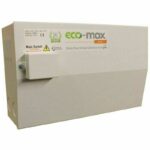 What is voltage optimisation? A voltage optimiser is a smart device that can help you save energy and reduce your carbon footprint. It works by adjusting the power supply from the National Grid to the ideal level for your electrical devices and appliances at home or work. This way, you can use less electricity and… Read more: Voltage Optimisers, What Are They and How Do They Work?
What is voltage optimisation? A voltage optimiser is a smart device that can help you save energy and reduce your carbon footprint. It works by adjusting the power supply from the National Grid to the ideal level for your electrical devices and appliances at home or work. This way, you can use less electricity and… Read more: Voltage Optimisers, What Are They and How Do They Work? - String Inverter vs Microinverter: Centralized vs Modular
 Imagine waking up to a sunny morning, not just because the birds are chirping, but because your roof is silently turning sunlight into clean energy for your entire home. That’s the beauty of solar power, but with all the different equipment options, it can feel overwhelming. One crucial decision you’ll face is choosing between string… Read more: String Inverter vs Microinverter: Centralized vs Modular
Imagine waking up to a sunny morning, not just because the birds are chirping, but because your roof is silently turning sunlight into clean energy for your entire home. That’s the beauty of solar power, but with all the different equipment options, it can feel overwhelming. One crucial decision you’ll face is choosing between string… Read more: String Inverter vs Microinverter: Centralized vs Modular - Why UK Homeowners with Solar Panels Need Bird Proofing (Beyond the Basics)
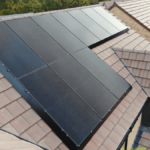 Imagine waking up to the quiet hum of your solar panels, generating clean energy to power your home. It’s a beautiful image, symbolizing lower electricity bills and sustainability. But what if a gang of birds decided the solar panels on your roof were the perfect spot for their new condo complex? Unfortunately, this idyllic scene… Read more: Why UK Homeowners with Solar Panels Need Bird Proofing (Beyond the Basics)
Imagine waking up to the quiet hum of your solar panels, generating clean energy to power your home. It’s a beautiful image, symbolizing lower electricity bills and sustainability. But what if a gang of birds decided the solar panels on your roof were the perfect spot for their new condo complex? Unfortunately, this idyllic scene… Read more: Why UK Homeowners with Solar Panels Need Bird Proofing (Beyond the Basics) - How AI could supercharge your solar panels
 Imagine stepping outside on a crisp January morning, a mug of steaming tea warming your hands. You glance at your rooftop, not with dread at energy bills, but with a mischievous grin. Why? Because the sun, that cheeky orb in the sky, is being squeezed for every juicy watt it holds thanks to your AI-powered… Read more: How AI could supercharge your solar panels
Imagine stepping outside on a crisp January morning, a mug of steaming tea warming your hands. You glance at your rooftop, not with dread at energy bills, but with a mischievous grin. Why? Because the sun, that cheeky orb in the sky, is being squeezed for every juicy watt it holds thanks to your AI-powered… Read more: How AI could supercharge your solar panels - New solar panel concept could reduce payback time to just five years
 Researchers have conducted a comprehensive analysis and determined that a ground-breaking renewable energy concept has the potential to significantly reduce the payback period for solar panels to less than five years. This innovative approach, known as agrivoltaics or Agri-PV, involves the integration of solar farms with “shadow-friendly” crops. A team of experts from the esteemed… Read more: New solar panel concept could reduce payback time to just five years
Researchers have conducted a comprehensive analysis and determined that a ground-breaking renewable energy concept has the potential to significantly reduce the payback period for solar panels to less than five years. This innovative approach, known as agrivoltaics or Agri-PV, involves the integration of solar farms with “shadow-friendly” crops. A team of experts from the esteemed… Read more: New solar panel concept could reduce payback time to just five years - Soak up the sunshine, because solar power is on fire!
 2023 was a record year for renewable energy, thanks in no small part to our sun-loving friend, solar. The International Energy Agency (IEA) says solar power added enough juice to the grid to power up half of all new renewable energy in 2023 – that’s a 50% jump! And this isn’t just a one-year blip,… Read more: Soak up the sunshine, because solar power is on fire!
2023 was a record year for renewable energy, thanks in no small part to our sun-loving friend, solar. The International Energy Agency (IEA) says solar power added enough juice to the grid to power up half of all new renewable energy in 2023 – that’s a 50% jump! And this isn’t just a one-year blip,… Read more: Soak up the sunshine, because solar power is on fire! - Reasons Why Solar Energy is the Ultimate Homeowner’s Investment
 In recent years, solar energy has emerged as a game-changer in the world of residential power generation. As concerns about the environment and rising utility costs continue to grow, homeowners are increasingly turning to solar energy as a sustainable and financially savvy solution. This article aims to explore the reasons why solar energy is the… Read more: Reasons Why Solar Energy is the Ultimate Homeowner’s Investment
In recent years, solar energy has emerged as a game-changer in the world of residential power generation. As concerns about the environment and rising utility costs continue to grow, homeowners are increasingly turning to solar energy as a sustainable and financially savvy solution. This article aims to explore the reasons why solar energy is the… Read more: Reasons Why Solar Energy is the Ultimate Homeowner’s Investment - Why Your Business Should Invest in Commercial Solar Panels
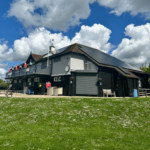 Solar panels on houses and residential properties have become increasingly common in the last year. The number of individuals seeking a more sustainable way of living continues to grow each year. However, the pursuit of a greener existence is not limited to domestic life. Investing in commercial solar panels is an excellent way to reduce… Read more: Why Your Business Should Invest in Commercial Solar Panels
Solar panels on houses and residential properties have become increasingly common in the last year. The number of individuals seeking a more sustainable way of living continues to grow each year. However, the pursuit of a greener existence is not limited to domestic life. Investing in commercial solar panels is an excellent way to reduce… Read more: Why Your Business Should Invest in Commercial Solar Panels

